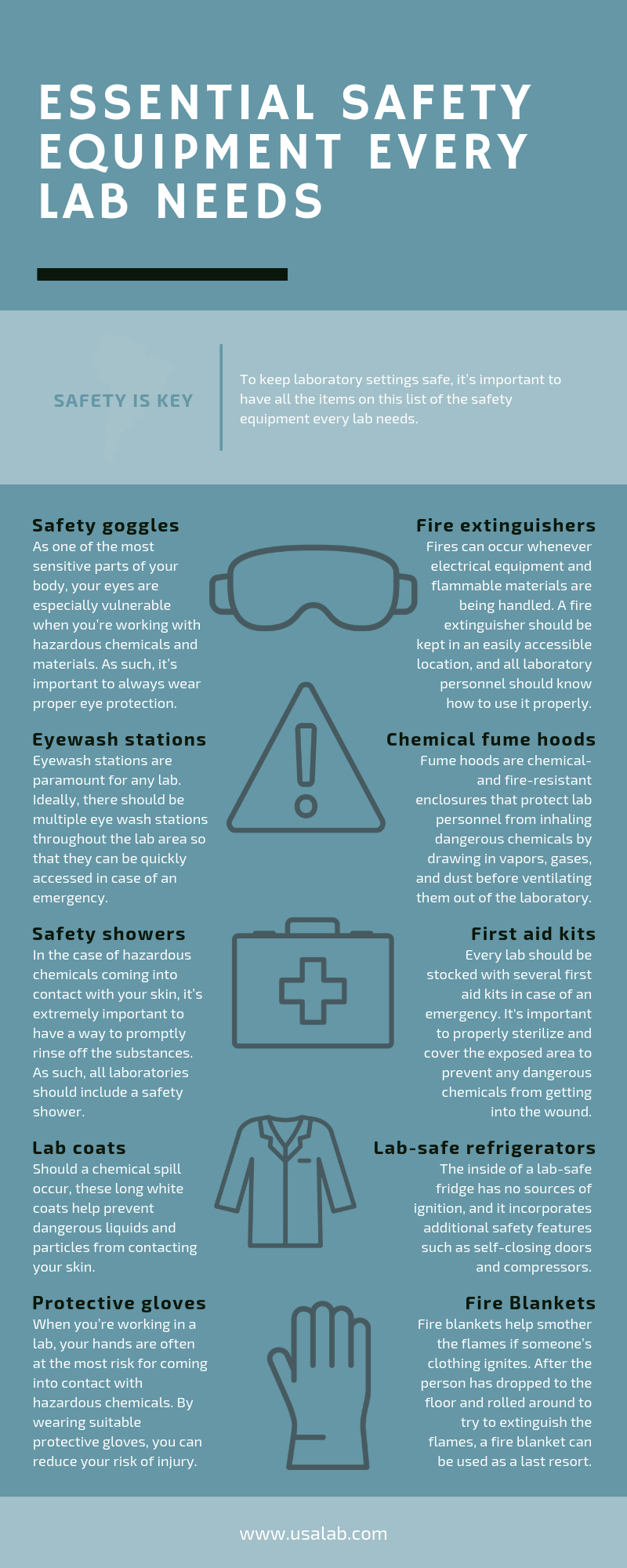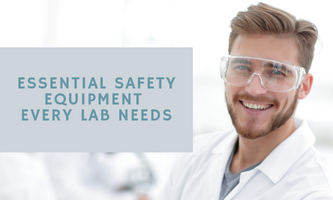Safety Equipment Tools in the Laboratory | USA Lab
Jul 3rd 2019
Due to the presence of many potentially harmful chemicals and pieces of equipment, laboratory settings come with certain safety risks. Common lab injuries include burns, lacerations, and chemical irritation and inhalation; it’s important for lab staff and researchers to take certain lab safety precautions to prevent such injuries. According to the Congressional Research Service, “In 2016, there were 6.9 million scientists and engineers… employed in the United States, accounting for 4.9% of total U.S. employment.” To keep this large section of the workforce safe, it’s important to have all the items on this list of the lab safety equipment tools.
Safety goggles
As one of the most sensitive parts of your body, your eyes are especially vulnerable when you’re working with hazardous chemicals and materials. As such, it’s important to always wear proper eye protection. Safety goggles are the ideal form of lab safety gear for your eyes because they shield both sides of your face to prevent materials from entering your eyes.
Choosing the right type of safety googles is essential. While some goggles are designed to protect against physical impact, chemical splash goggles are ideal for those who work with chemicals. In addition, some goggles also protect from laser or UV light hazards.
Eyewash stations
You should always wear proper eye protection when working in a lab, but accidents can happen. If any chemicals or broken glass get in or around someone’s eyes, they must wash out the foreign material immediately to reduce the chances of chemical burns, blindness, and other forms of permanent damage. As such, eyewash stations are paramount for any lab. Ideally, there should be multiple eye wash stations throughout the lab area so that they can be quickly accessed in case of an emergency.
Safety showers
In the case of hazardous chemicals coming into contact with your skin, it’s extremely important to have a way to promptly rinse off the substances. As such, all laboratories should include a safety shower. After removing any contaminated clothing, the affected person can enter the shower and pull an overhead handle to drench themselves with water. Doing so will help prevent serious injuries associated with prolonged chemical exposure.
Lab coats
Lab coats aren’t just worn to make a fashion statement—they are also proper laboratory safety equipment. Should a chemical spill occur, these long white coats help prevent dangerous liquids and particles from contacting your skin. Because the coats are often made of absorbent materials, however, they should be promptly removed if a spill occurs. Doing so will prevent chemicals from soaking through to the skin. For ideal protection, lab coats should always be buttoned closed.
Protective gloves
When you’re working in a lab, your hands are often at the most risk for coming into contact with hazardous chemicals. By wearing suitable protective gloves, you can reduce your risk of injury. The main types of disposable gloves are made of latex or nitrile. If you’re working with stronger chemicals or heat, however, you may need extra lab safety gear protection. Gloves with stronger protection include chemical- and heat-resistant gloves. Before choosing which type of gloves to wear, carefully read the appropriate material safety data sheets to determine the level of protection you’ll need while in the lab.
Fire extinguishers
Fires can occur whenever electrical equipment and flammable materials are being handled, so a fire extinguisher is a very important piece of lab safety equipment. It should be kept in an easily accessible location, and all laboratory personnel should know how to use it properly. It’s also important to stock your lab with the correct type of fire extinguisher based on the expected emergencies. There are four main fire extinguishers to choose from, each of which has a different use. Class A extinguishers are used for ordinary combustibles, while Class B extinguishers are used for flammable liquids and gases. Class C fire extinguishers are for electrical equipment, and Class D extinguishers are for combustible metals and metal alloys. If you don’t use the right type of extinguisher, it may fail to put out the fire or even make it worse.
Chemical fume hoods
If your laboratory works with chemicals of any kind, a chemical fume hood is an essential piece of lab safety equipment. Fume hoods are chemical- and fire-resistant enclosures that protect lab personnel from inhaling dangerous chemicals by drawing in vapors, gases, and dust before ventilating them out of the laboratory. Having one of these in your lab will reduce the harmful effects of chemical inhalation and exposure.
First aid kits
It may seem obvious, but the importance of a first aid kit should not be underestimated. Every lab should be stocked with several first aid kits in case of an emergency. Even if you only suffer a minor injury, it’s important to properly sterilize and cover the exposed area to prevent any dangerous chemicals from getting into the wound. First aid kits should include bandages, tweezers, sterilizing wipes, sterile dressings, gauze, antiseptic cream, scissors, and eye dressings. Make sure that the first aid kits are restocked frequently and stored in easily accessible areas.
Laboratory-safe refrigerators
Flammable liquids should always be stored in cool environments. Storing flammable equipment in domestic refrigerators, however, can pose a serious safety hazard. This risk occurs because regular refrigerators contain exposed sources of ignition and because their temperatures are simply too high. As such, a laboratory-safe refrigerator is a necessary piece of laboratory safety equipment. The inside of this chiller lab equipment has no sources of ignition, and it incorporates additional safety features such as self-closing doors, compressors, and magnetic door gaskets.
Fire Blankets
A fire blanket is also vital for laboratories that handle flammable liquids. Fire blankets help smother the flames if someone’s clothing ignites. After the person has dropped to the floor and rolled around to try to extinguish the flames, a fire blanket can be used as a last resort. As with any lab safety equipment, the blanket should be kept in an unobstructed, easily accessible area.
Every lab needs this safety equipment in order to properly protect all laboratory personnel. If your lab requires new or used equipment, USA Lab Equipment offers a variety of quality products with competitive pricing. With over 1,000 items consisting of safety equipment in the laboratory, we’re sure to have the item you’re looking for.


